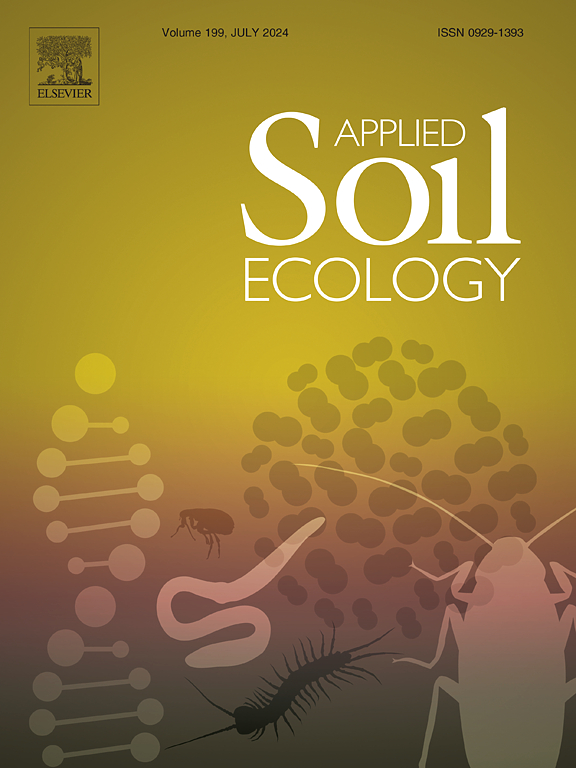Opposing island biogeographic effects of turnover and nestedness on beta-diversity of soil faunal communities between woodland and deforested grassland
IF 5
2区 农林科学
Q1 SOIL SCIENCE
引用次数: 0
Abstract
Human land use intensification is increasing biodiversity loss worldwide through fragmenting contiguous natural habitats into spatially isolated patches of varying sizes. However, it is poorly known as to how the area and isolation of patches operate to jointly alter biological community composition for contrasting land use types, particularly for belowground organisms. Oceanic islands that vary in human activities provide an ideal model system for examining how patch area and isolation affects community dissimilarity resulting from land use change. We conducted a paired sampling design that included both natural woodland (i.e. land covered with woody plants, including trees and shrubs) and degraded grassland for each of 20 islands differing in area and remoteness in the largest archipelago of Eastern China. We used this design to investigate how island area and remoteness shape the community dissimilarity of soil fauna between woodland and grassland directly and indirectly through changing climatic and habitat properties. The dissimilarity of soil fauna communities for each island was estimated by measuring total beta (β) diversity and its turnover and nestedness components between woodland and grassland. We found that land use change did not decrease taxa richness but did alter community composition overall. There was no relationship of island area with community dissimilarity when it was estimated by total β-diversity, due to contrasting responses of its turnover and nestedness components to island area. Soil faunal compositional dissimilarity between woodland and grassland along the area gradient was mainly related to the gain and loss of unique taxa in grassland. On small islands, nestedness was the primary contributor to total β-diversity, due to a loss of soil fauna taxa as habitats shifted from woodland to grassland, and suggests that natural habitats serve as refuges for soil organisms. Meanwhile on larger islands, turnover was the main contributor to total β-diversity, suggesting that diverse land uses can increase biodiversity across habitats. Additionally, high habitat differences combined with favorable climatic conditions (such as low wind speed) on larger islands facilitated species turnover but diminished nestedness. Meanwhile island remoteness did not affect total β-diversity or its components, but it did significantly enhance the negative impact of land-use conversion on the abundance of larger-bodied taxa. These findings suggest that island area, and therefore landscape patch area, play a crucial role in shaping the dissimilarity of soil faunal communities that stem from human land use change. Our results highlight that partitioning total β-diversity into its turnover and nestedness components is essential for understanding the impact of land use change on soil faunal community composition in fragmented habitats.
林地和毁林草地土壤动物群落β -多样性的倒立岛生物地理效应
人类土地利用集约化将连续的自然栖息地破碎成空间上孤立的大小不等的斑块,从而加剧了世界范围内生物多样性的丧失。然而,对于斑块的面积和隔离如何共同改变不同土地利用类型的生物群落组成,特别是地下生物,人们知之甚少。人类活动不同的大洋岛屿为研究斑块面积和隔离如何影响土地利用变化导致的群落差异提供了理想的模型系统。我们对中国东部最大群岛的20个岛屿进行了配对抽样设计,包括自然林地(即树木和灌木等木本植物覆盖的土地)和退化草地。本设计探讨了海岛地区和偏远地区如何通过气候和生境的变化直接或间接地影响林地和草地土壤动物群落的差异。通过测定林地和草地土壤动物群落的总β (β)多样性及其周转量和巢性组分,估算了各岛屿土壤动物群落的差异性。研究发现,土地利用变化并未降低群落丰富度,但总体上改变了群落组成。总β-多样性估算的岛屿面积与群落差异没有关系,主要是由于其周转和筑巢成分对岛屿面积的响应存在差异。林地与草地土壤动物组成在面积梯度上的差异主要与草地特有类群的增减有关。在小岛屿上,由于生境从林地转向草地导致土壤动物类群的减少,巢性是总β多样性的主要贡献者,这表明自然生境是土壤生物的避难所。与此同时,在较大的岛屿上,周转量是总β多样性的主要贡献者,这表明不同的土地利用可以增加不同栖息地的生物多样性。此外,较大岛屿上的高生境差异加上有利的气候条件(如低风速)促进了物种更替,但减少了筑巢。海岛荒无性不影响总β多样性及其组成,但显著增强了土地利用转换对大体类群丰度的负面影响。这些发现表明,岛屿区域以及景观斑块区域在人类土地利用变化导致的土壤动物群落差异的形成中起着至关重要的作用。我们的研究结果表明,将总β-多样性划分为其周转和筑巢成分对于理解土地利用变化对破碎化栖息地土壤动物群落组成的影响至关重要。
本文章由计算机程序翻译,如有差异,请以英文原文为准。
求助全文
约1分钟内获得全文
求助全文
来源期刊

Applied Soil Ecology
农林科学-土壤科学
CiteScore
9.70
自引率
4.20%
发文量
363
审稿时长
5.3 months
期刊介绍:
Applied Soil Ecology addresses the role of soil organisms and their interactions in relation to: sustainability and productivity, nutrient cycling and other soil processes, the maintenance of soil functions, the impact of human activities on soil ecosystems and bio(techno)logical control of soil-inhabiting pests, diseases and weeds.
 求助内容:
求助内容: 应助结果提醒方式:
应助结果提醒方式:


